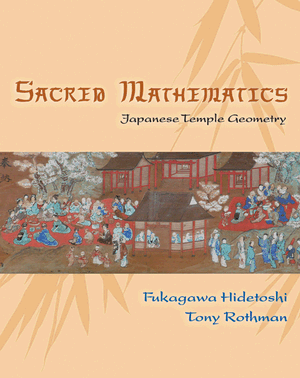Tal y como aparece en la Wikipedia, un SANGAKU no es más que "una tablilla de madera con figuras geométricas, ubicadas en los templos y santuarios como ofrendas votivas a los dioses o como desafíos a los congregados y visitantes, escritos en kanbun, una forma antigua de japonés. Cada tablilla sangaku contiene entre 1 y 10 problemas, y cada problema está formado de la siguiente manera: arriba (o a la derecha) de la tablilla se ubican las figuras geométricas; abajo (o a la izquierda) se encuentran la pregunta y soluciones (procedimiento, respuesta, o ambas si las hay); y por último el creador del sangaku, el profesor, la escuela y la fecha de su colgado."
Os dejo a continuación con el resumen que el propio autor ha hecho de lo que va a contar. Aviso que está en Inglés.
Brief history of traditional Japanese Mathematics.
Before 17th century, there was no mathematics in Japan but calculations only for tax. Sangi, computing rods, a notable Chinese technology, were used extensively in Japan. However, many old Chinese mathematics books were imported into Japan, there were no mathematician who could recognize it.
When Japan was engaged in trade with Asian countries including China, just before Edo-period (1603-1867), a good calculator “SOROBAN” or Abacus was imported into Japan from China. This calculator was so much better than “SANGI” that many Japanese people wanted to know how to use it. Many SOROBAN clubs arose all over the Japan and ordinary people got the ability of using SOROBAN and so the teachers of those clubs got some money. The teachers didn’t need any license but acted freely.
The first book of traditional Japanese mathematics, titled, “JINKOUKI” was published in 1627, the book got a big market and became a best seller. It was a workbook on SOROBAN. From the seventeenth century, many SOROBAN clubs arose all over the Japan and so many mathematicians appeared, and one of them was Seki Takakazu (1640?-1708). Ordinary people enjoyed calculation in clubs, as much as “BAR” in your country. In the country side, people who had an interest in calculation or mathematics visited nearby small private Soroban clubs. In cities. some Samurais visited Soroban club for their business and enjoyed discussing on mathematics.
Many teachers of the mathematics clubs got commutation with each other on mathematic problems and so they constructed a wonderful mathematics world, independent from the west. In the age, there were no universities in Japan. This world didn’t depend on academia but on ordinary people. They enjoyed “Discussing on mathematics problems” as a hobby. Japanese people used to hung wooden tablets under the eaves of shrines and temples, on which beautiful art, prayer or poems were wrote. They used this custom. Lovers of mathematics drew geometric problems on the tablets and devoted to nearby shrines or temples and so they were proud of his achievement of mathematics in public. “Solve this problem if you can !”. These tablets were called “SANGAKU” or mathematics tablets in literally.
The new government, after Edo-period (1603-1867), decided to throw away the traditional Japanese mathematics and adopted the western mathematics and so traditional Japanese Mathematics world become “Forgotten world”. But about 900 sangaku tablets are survived.
Theorems in the Forgotten traditional Japanese Mathematics world.
This world arose and developed in only two hundred years, based on old Chinese Mathematics. This world started by using Pythagorean Theorem only, fund in old Chinese, independent from the west. In 17th to 19th centuries, lovers of mathematics studied and discussed so that original mathematics world arose and developed without academia and universities. In particular, study of figures developed so that they obtained some same theorems as in west; Descartes Circle theorem. Soddy’s hexlet, Feuer Bach circle, Bernoulli numbers and Euler’s theorem on spherical triangle. Many theorems on the ellipse are peculiar to Japanese mathematics. In integer theory, Ajima Naonobu (1732-1798) solved the “Fermat-Pell equation” completely. Sangaku aimed to appeal to visitor interesting and so sangaku problems were drawn in color. We look so beautiful patterns in Alhambra in Granada.
This forgotten world provide many nice problems to modern mathematics education.
References:
[1] Fukagawa Hidetoshi & Tony Rothman,”Sacred Mathematic”. Princeton University Press,2008
[2] FUKAGAWA,Hidetoshi:”SANGAKU:Las tabletas matematicas de madera japonesas”, Tranduccion del ingtes por Francisco Bellot.Matematica Gaceta,VOLUMEN 1, NUMERO 2,p.137-p.142.1988.
[3] J.ARIAS REYNA and DAVID CLARK, “A Modern Solution to The GION SHRINE PROBLEM. “ June 22,2013.
Esta conferencia se enmarca dentro del nuevo Coloquio de Divulgación "Ciencia y Matemáticas", que estrenamos con esta charla, y se financia gracias al Vicerrectorado de Investigación de la Universidad de Sevilla, a través del V Plan Propio de Investigación. La organización, como en otras ocasiones, viene a cargo de mi compañera y advisor María del Carmen Calderón Moreno y un servidor. Asimismo, quiero agradecer tanto a la Facultad de Matemáticas como al IMUS su implicación en este proyecto.
Como en otras ocasiones, y por si no te puedes pasar a verla in situ, tenemos pensado grabar la conferencia (muchas gracias @Raven_Neo por tu apoyo) para subirla y que todos la podáis ver.
Tito Eliatron Dixit



No hay comentarios:
Publicar un comentario
Si no comentas, Gauss se comerá una integral.
Y, por favor, respeta a todos con tus opiniones.